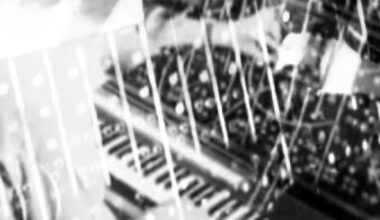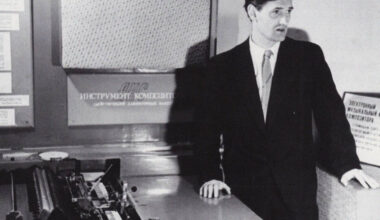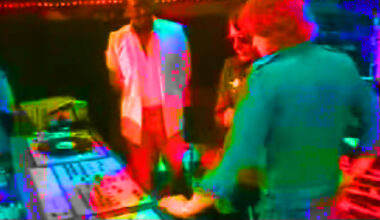Anyone else wondered what’d happen if we set the dial on the Electronic Sound time machine to the future? Welcome to the 22nd century where Brian Eno has some explaining to do…

“I was a pariah.” The comment comes as no surprise. Brian Eno is on his veranda, daiquiri in hand, his pod overlooking the Sea of Tranquility. He is a picture of health considering his age, and yet when you ask him about the past, he looks up with an uneasy expression at the small, blue Earth suspended in the sky. He talks about the empty seats at his 200th birthday party. About the hate vid-mail he received. About the move to relative isolation on the moon. His recollections are slow and considered. “It really was a very difficult time, I can tell you,” he says, in what you’re about to realise is the 22nd century’s greatest understatement.
“In one sense, I saved the day. That’s what the e-papers said. They went from ‘Eno-maniac’ to ‘Eno The Hero’, and all the websites wanted to speak to me, to get my take on things,” he chuckles. “But the public hated me for what happened. They blamed me, even though it wasn’t me. It literally wasn’t me. It was the GrowStar replicas of me. At the end of the day, my whole music career was based on synthesis of some kind: who’s going to distinguish between a real Brian Eno and 20 million rampant fake ones?”
He chuckles again, but this time his laughter sounds thinner.
It’s easy to forget but, the GrowStars were not an overnight phenomenon. The idea was simple: develop sea monkeys – the shrimp-like aquarium pets once popular with 20th century children – into a steroid-accelerated celebrity range. The SyCo Corporation took the lead, launching a pop star range to mark the 125th series of ‘The X Factor’, but the formula wasn’t right. The political versions were no better: a GrowStar of then-UKIP PM Tristram Digby-Turret famously shrivelled into a grotesque mess. Then, inspired by a string of Pet Shop Droids hit singles in the early 2130s, Apple marked Ultravox’s 150th anniversary by using ‘Vienna’ as the start-up music for their latest 3-D tablet. Sales of a GrowStar Midge Ure went through the roof. Almost literally according to one Amazon review at the time:
“I give this product five stars but it made a right mess. I unpack it no problem. It started small so I added water and day by day my little midge ure grew. They say to put it on mantelpiece when full size, but we had a rain leak and the growstar midge ure grew so big it make green mark on my ceiling. I use mop but the stain still there. It put me right off midge ure. Now I prefer system of romance era with the john foxx. Good packaging. Arrive quick. Would buy again.”
Before long, every living room had a GrowStar. Each would start as a small green blob, then with the application of water, grow into swampy replicas of the act they were meant to be: Devo for the cool kids, Duran Duran for the mainstreamers, The Human League for the party monsters. And grow they did: some GrowStars were big enough to help with chores such as dusting, hoovering and basic DIY.
Brian Eno remembers: “My first thought was to not get involved, to do a Gary Numan and block any use of my brand in GrowStar technology. Of course, he learnt that from the cloning disaster of 2047. But this was a new century, nobody was into ‘Another Green World’ anymore, and I thought if I could couple GrowStar retail sales with download codes, I may raise enough money to fix all my old synths.”
SyCo had bought the patent, so Brian had a brief vid-mail with the artificial voicebox attached to Simon Cowell’s brain – the only organ remaining of the 21st century pop mogul. “Pretty amazing what they can do with diodes these days,” says Brian. A limited run of Brian Eno GrowStars – branded EnoStar – hit the shelves on 20 June 2140 to coincide with a krillstep remix of ‘Music For Airports’. As it happened, krillstep was the biggest thing since spasmwave and, as a result, the EnoStar sold its millionth unit within three weeks.
“All those houses with gloopy, damp replicas of me,” says Eno, refilling his drink. “I said to my friend Robot Tony Visconti that I was uncomfortable with it all. I mean, what’s an Andy McCluskey GrowStar going to do? A bit of ironing, put up a shelf, maybe a bit of grouting? But a GrowStar Brian Eno, though: you never know what it’s going to do.”
In October 2140, A Flock Of Cyborgs were at Number One, Adele was still in the album chart and the first report of an EnoStar massacre hit the news wires. Six Anglesey port workers were devoured by a 20-foot Brian with accelerated growth from falling into the dock. There was a similar incident at a swimming pool in Boston. The carnage that followed has been well documented, not least in ‘The Guinness Book Of Pop Star Blunders’ (ed Thaddeus Gambuccini, 2048), which noted that at the height of the EnoStar disaster, the average person was 50 times more likely to be chomped by an errant Eno than to get injured in a car accident. “I wouldn’t want either, to be honest,” Eno says with a wry smile.
“Sales dropped significantly,” he continues. “Not that it was ever about the sales, of course, but no one’s going to buy a GrowStar Brian Eno if it’s likely to eat your face in the middle of the night. It’s fair to say my reputation suffered somewhat. ‘Another Day On Earth’ got mixed reviews, but this was another level. By the end of the decade, I was public enemy number one. I moved here because I was forced from Earth.”
It’s an elegant moon pod, all curves and white surfaces, leased off the SyCo corporation in a deal Eno refuses to discuss. It’s tempting to ask him about regrets, but there’s one upside we haven’t discussed yet, and our allocated interview time is drawing to a close. Eno finishes his daiquiri, chews on a slice of lime and then reaches for a plate. On the plate is a green, slimy hand. An EnoStar hand. He pauses for a moment, then eats the thumb.
When did he know?
“It took six visits to a doctor,” he says, mouth full. “None of that was cheap I can tell you. Turns out, eating EnoStars slows the body’s cell deterioration by a significant degree. It’s not eternal life, but I’m 204 years old and I can almost touch my toes. They’re not easy to hunt, of course, but they’re rich in omega-3 and they’re saving the NHS a fortune. It’s nice something positive came from something so horrible. I may release an album about it. Maybe. When things have calmed down a little.”
The earth is setting and the purple lights of the moon pod cast oval patterns across the Tranquility crater. All these years later, it’s hard to think that krillstep or 1980s electronica droids will be popular again – but even harder to think that the universe’s longest surviving music producer won’t once again assume his former title of Eno The Hero.





